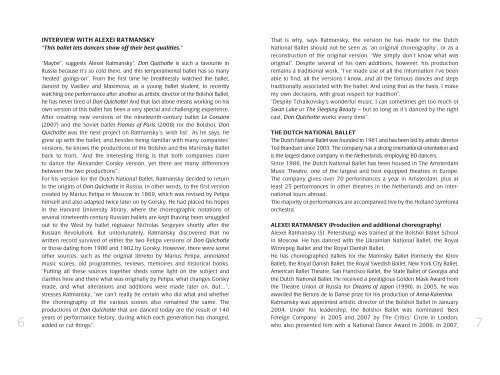Erfolgreiche ePaper selbst erstellen
Machen Sie aus Ihren PDF Publikationen ein blätterbares Flipbook mit unserer einzigartigen Google optimierten e-Paper Software.
INTERVIEW WITH ALEXEI RATMANSKY<br />
“This ballet lets dancers show off their best qualities.”<br />
“Maybe”, suggests Alexei Ratmansky”, Don Quichotte is such a favourite in<br />
Russia because it’s so cold there, and this temperamental ballet has so many<br />
‘heated’ goings-on”. From the first time he breathlessly watched the ballet,<br />
danced by Vasiliev and Maximova, as a young ballet student, to recently<br />
watching one performance after another as artistic director of the Bolshoi Ballet,<br />
he has never tired of Don Quichotte! And that fact alone means working on his<br />
own version of this ballet has been a very special and challenging experience.<br />
After creating new versions of the nineteenth-century ballet Le Corsaire<br />
(2007) and the Soviet ballet Flames of Paris (2008) for the Bolshoi, Don<br />
Quichotte was the next project on Ratmansky’s ‘wish list’. As he says, he<br />
grew up with the ballet, and besides being familiar with many companies’<br />
versions, he knows the productions of the Bolshoi and the Mariinsky Ballet<br />
back to front. “And the interesting thing is that both companies claim<br />
to dance the Alexander Gorsky version, yet there are many differences<br />
between the two productions”.<br />
For his version for the Dutch National Ballet, Ratmansky decided to return<br />
to the origins of Don Quichotte in Russia. In other words, to the first version<br />
created by Marius Petipa in Moscow in 1869, which was revised by Petipa<br />
himself and also adapted twice later on by Gorsky. He had placed his hopes<br />
in the Harvard University library, where the choreographic notations of<br />
several nineteenth-century Russian ballets are kept (having been smuggled<br />
out to the West by ballet régisseur Nicholas Sergeyev shortly after the<br />
Russian Revolution). But unfortunately, Ratmansky discovered that no<br />
written record survived of either the two Petipa versions of Don Quichotte<br />
or those dating from 1900 and 1902 by Gorsky. However, there were some<br />
other sources, such as the original libretto by Marius Petipa, annotated<br />
music scores, old programmes, reviews, memoires and historical books.<br />
“Putting all these sources together sheds some light on the subject and<br />
clarifies here and there what was originally by Petipa, what changes Gorsky<br />
made, and what alterations and additions were made later on. But…”,<br />
stresses Ratmansky, “we can’t really be certain who did what and whether<br />
the choreography of the various scenes also remained the same. The<br />
productions of Don Quichotte that are danced today are the result of 140<br />
years of performance history, during which each generation has changed,<br />
That is why, says Ratmansky, the version he has made for the Dutch<br />
National Ballet should not be seen as ‘an original choreography’, or as a<br />
reconstruction of the original version. “We simply don’t know what was<br />
original”. Despite several of his own additions, however, his production<br />
remains a traditional work. “I’ve made use of all the information I’ve been<br />
able to find, all the versions I know, and all the famous dances and steps<br />
traditionally associated with the ballet. And using that as the basis, I make<br />
my own decisions, with great respect for tradition”.<br />
“Despite Tchaikovsky’s wonderful music, I can sometimes get too much of<br />
Swan Lake or The Sleeping Beauty – but so long as it’s danced by the right<br />
cast, Don Quichotte works every time”.<br />
THE DUTCH NATIONAL BALLET<br />
The Dutch National Ballet was founded in 1961 and has been led by artistic director<br />
Ted Brandsen since 2003. The company has a strong international orientation and<br />
is the largest dance company in the Netherlands, employing 80 dancers.<br />
Since 1986, the Dutch National Ballet has been housed in The Amsterdam<br />
Music Theatre, one of the largest and best equipped theatres in Europe.<br />
The company gives over 70 performances a year in Amsterdam, plus at<br />
least 25 performances in other theatres in the Netherlands and on international<br />
tours abroad.<br />
The majority of performances are accompanied live by the Holland Symfonia<br />
orchestra.<br />
ALEXEI RATMANSKY (Production and additional choreography)<br />
Alexei Ratmansky (St. Petersburg) was trained at the Bolshoi Ballet School<br />
in Moscow. He has danced with the Ukrainian National Ballet, the Royal<br />
Winnipeg Ballet and the Royal Danish Ballet.<br />
He has choreographed ballets for the Mariinsky Ballet (formerly the Kirov<br />
Ballet), the Royal Danish Ballet, the Royal Swedish Ballet, New York City Ballet,<br />
American Ballet Theatre, San Francisco Ballet, the State Ballet of Georgia and<br />
the Dutch National Ballet. He received a prestigious Golden Mask Award from<br />
the Theatre Union of Russia for Dreams of Japan (1998). In 2005, he was<br />
awarded the Benois de la Danse prize for his production of Anna Karenina.<br />
Ratmansky was appointed artistic director of the Bolshoi Ballet in January<br />
2004. Under his leadership, the Bolshoi Ballet was nominated ‘Best<br />
Foreign Company’ in 2005 and 2007 by The Critics’ Circle in London,<br />
6 added or cut things”.<br />
who also presented him with a National Dance Award in 2006. In 2007,<br />
7


